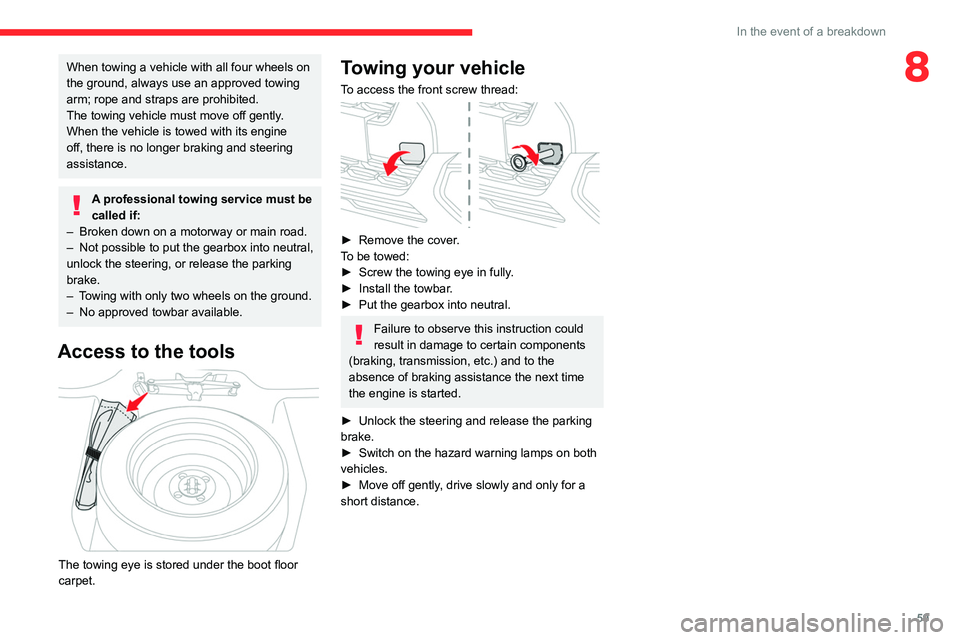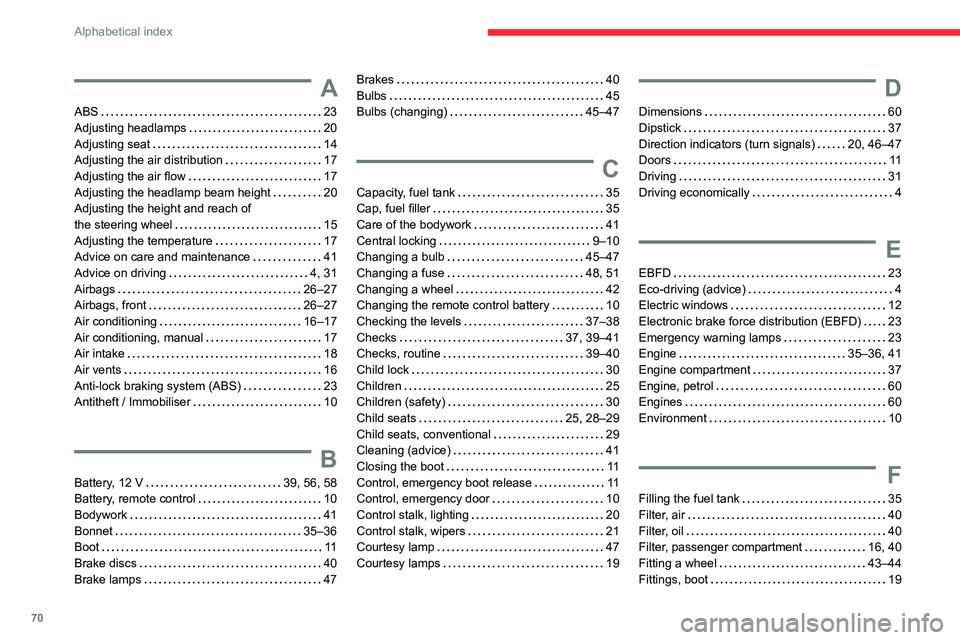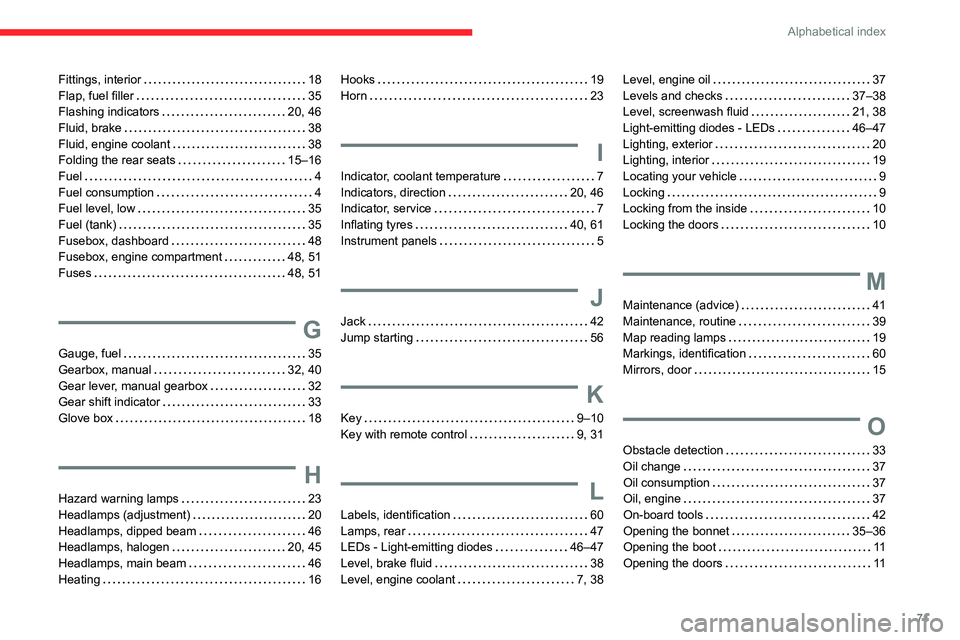warning CITROEN C3 2023 User Guide
[x] Cancel search | Manufacturer: CITROEN, Model Year: 2023, Model line: C3, Model: CITROEN C3 2023Pages: 104, PDF Size: 2.38 MB
Page 37 of 104

35
Practical information
7Refuelling
Fuel tank capacity: 30 litres.
Reserve level: approximately 5 litres.
Low fuel level
When the low fuel level is reached, this
warning lamp comes on on the instrument
panel, accompanied by an audible signal. When
it first comes on, about 5 litres of fuel remain.
Until sufficient fuel is added, this warning lamp
appears every time the ignition is switched on,
accompanied by an audible signal. When driving,
the audible signal are repeated with increasing
frequency as the fuel level drops towards 0.
You must refuel as soon as possible to avoid
running out of fuel.
Refuelling
Additions of fuel must be of at least 5 litres, in
order to be registered by the fuel gauge.
Opening the filler cap may create a noise caused
by an inrush of air. This vacuum is entirely
normal, resulting from the sealing of the fuel
system.
To refuel in complete safety:
►
Y
ou must switch off the engine.
► Lift the fuel filler flap lever , located on the
floor beside the driver's seat, to open the flap.
►
T
ake care to select the pump that delivers the
correct fuel type for the vehicle's engine (see a
reminder label on the inside of the filler flap).
► Turn the filler cap to the left and remove it.
► Introduce the filler nozzle and push it in as
far as possible before starting to refuel (risk of
blowback).
►
Fill the tank.
Do not continue past the first cut-off of the
nozzle, as this may cause malfunctions.
► Refit the filler cap.
► T urn it to the right.
►
Push the filler flap to close it.
If you have put in wrong/dirty/
contaminated fuel or H2O mixed fuel in
the vehicle, you must have the fuel tank
drained and filled with the correct fuel before
starting the engine.
Contact a CITROËN dealer for the fuel
system cleaning.
The vehicle is fitted with a catalytic converter, a
device which helps to reduce the level of harmful
emissions in the exhaust gases.
You must use unleaded fuel.
The filler neck is narrower, admitting unleaded
petrol nozzles only.
Fuel cut-off
Your vehicle is equipped with a safety device
which cuts off the fuel supply in the event of a
collision.
Bonnet
When the engine is hot, handle the
exterior safety catch and the bonnet stay
with care (risk of burns), using the protected
area.
When the bonnet is open, take care not to
damage the safety catch.
Page 61 of 104

59
In the event of a breakdown
8When towing a vehicle with all four wheels on
the ground, always use an approved towing
arm; rope and straps are prohibited.
The towing vehicle must move off gently.
When the vehicle is towed with its engine
off, there is no longer braking and steering
assistance.
A professional towing service must be
called if:
–
Broken down on a motorway or main road.
–
Not possible to put
the gearbox into neutral,
unlock the steering, or release the parking
brake.
–
T
owing with only two wheels on the ground.
–
No approved towbar available.
Access to the tools
The towing eye is stored under the boot floor
carpet.
Towing your vehicle
To access the front screw thread:
► Remove the cover .
To be towed:
►
Screw the towing eye in fully
.
►
Install the towbar
.
►
Put the gearbox into neutral.
Failure to observe this instruction could
result in damage to certain components
(braking, transmission, etc.) and to the
absence of braking assistance the next time
the engine is started.
►
Unlock the steering and release the parking
brake.
►
Switch on the hazard warning lamps on both
vehicles.
►
Move off gently
, drive slowly and only for a
short distance.
Page 64 of 104

62
10" Touch Screen
10" Touch Screen
Multimedia audio system
The functions and settings described may vary according to the vehicle version
and configuration.
Driving while distracted can result in loss
of vehicle control, crash and injury. We
strongly recommend that you use extreme
caution when using any device that may take
your focus off the road.
Your primary responsibility is the safe
operation of your vehicle.
We recommend against the use of any hand-
held device while driving and encourage
the use of voice-operated systems when
possible.
Make sure you are aware of all applicable
local laws that may affect the use of electronic
devices while driving.
For safety reasons and because they
require sustained attention by the driver,
the following operations must be carried out
with the vehicle stationary and the ignition on:
–
Pairing the smartphone with the system in
Bluetooth® mode.
–
Connection to the Apple CarPlay® or
Android Auto applications.
–
Using the smartphone.
– Changing the system settings and
configuration.
Some functions are not accessible when
driving.
Overheating
In very hot conditions, operation may be
limited to protect the system (e.g. volume may
be reduced). A warning message is displayed
on the screen.
The system will resume normal operation
when the temperature in the passenger
compartment has dropped.
The system is protected in such a way that it will only operate in the vehicle.
For more information about smartphones
and OS compatibility, refer to the
following website:
https://citroen.in/citroen-connectivity
General information
Getting to know your
system
The system allows you to interact with a variety
of features using the touch screen and voice
commands. By integrating with your Bluetooth
®-enabled
phone, the touch screen provides easy
interaction with audio, multimedia, navigation,
and your phone's compatible applications.
Your system is equipped with a feature that
allows you to access and control audio features
for 60 minutes after you switch the ignition off
(until the doors are locked using the remote
control).
Layout of the touch screen
To operate the touch screen, simply touch the
item or option that you want to choose. The
button changes colour when you select it.
1. Display off (short press)
Power off (long press)
2. Connected device status with battery and
signal strength (when mobile phone is
connected)
3. Status bar
This bar displays icons and messages
pertaining to current system activities.
4. Date and time
5. Global volume control
6. Menus
Page 72 of 104

70
Alphabetical index
A
ABS 23
Adjusting headlamps
20
Adjusting seat
14
Adjusting the air distribution
17
Adjusting the air flow
17
Adjusting the headlamp beam height
20
Adjusting the height and reach of
the steering wheel
15
Adjusting the temperature
17
Advice on care and maintenance
41
Advice on driving
4, 31
Airbags
26–27
Airbags, front
26–27
Air conditioning
16–17
Air conditioning, manual
17
Air intake
18
Air vents
16
Anti-lock braking system (ABS)
23
Antitheft / Immobiliser
10
B
Battery, 12 V 39, 56, 58
Battery, remote control
10
Bodywork
41
Bonnet
35–36
Boot
11
Brake discs
40
Brake lamps
47
Brakes 40
Bulbs
45
Bulbs (changing)
45–47
C
Capacity, fuel tank 35
Cap, fuel filler
35
Care of the bodywork
41
Central locking
9–10
Changing a bulb
45–47
Changing a fuse
48, 51
Changing a wheel
42
Changing the remote control battery
10
Checking the levels
37–38
Checks
37, 39–41
Checks, routine
39–40
Child lock
30
Children
25
Children (safety)
30
Child seats
25, 28–29
Child seats, conventional
29
Cleaning (advice)
41
Closing the boot
11
Control, emergency boot release
11
Control, emergency door
10
Control stalk, lighting
20
Control stalk, wipers
21
Courtesy lamp
47
Courtesy lamps
19
D
Dimensions 60
Dipstick
37
Direction indicators (turn signals)
20, 46–47
Doors
11
Driving
31
Driving economically
4
E
EBFD 23
Eco-driving (advice)
4
Electric windows
12
Electronic brake force distribution (EBFD)
23
Emergency warning lamps
23
Engine
35–36, 41
Engine compartment
37
Engine, petrol
60
Engines
60
Environment
10
F
Filling the fuel tank 35
Filter, air
40
Filter, oil
40
Filter, passenger compartment
16, 40
Fitting a wheel
43–44
Fittings, boot
19
Page 73 of 104

71
Alphabetical index
Fittings, interior 18
Flap, fuel filler
35
Flashing indicators
20, 46
Fluid, brake
38
Fluid, engine coolant
38
Folding the rear seats
15–16
Fuel
4
Fuel consumption
4
Fuel level, low
35
Fuel (tank)
35
Fusebox, dashboard
48
Fusebox, engine compartment
48, 51
Fuses
48, 51
G
Gauge, fuel 35
Gearbox, manual
32, 40
Gear lever, manual gearbox
32
Gear shift indicator
33
Glove box
18
H
Hazard warning lamps 23
Headlamps (adjustment)
20
Headlamps, dipped beam
46
Headlamps, halogen
20, 45
Headlamps, main beam
46
Heating
16
Hooks 19
Horn
23
I
Indicator, coolant temperature 7
Indicators, direction
20, 46
Indicator, service
7
Inflating tyres
40, 61
Instrument panels
5
J
Jack 42
Jump starting
56
K
Key 9–10
Key with remote control
9, 31
L
Labels, identification 60
Lamps, rear
47
LEDs - Light-emitting diodes
46–47
Level, brake fluid
38
Level, engine coolant
7, 38
Level, engine oil 37
Levels and checks
37–38
Level, screenwash fluid
21, 38
Light-emitting diodes - LEDs
46–47
Lighting, exterior
20
Lighting, interior
19
Locating your vehicle
9
Locking
9
Locking from the inside
10
Locking the doors
10
M
Maintenance (advice) 41
Maintenance, routine
39
Map reading lamps
19
Markings, identification
60
Mirrors, door
15
O
Obstacle detection 33
Oil change
37
Oil consumption
37
Oil, engine
37
On-board tools
42
Opening the bonnet
35–36
Opening the boot
11
Opening the doors
11
Page 74 of 104

72
Alphabetical index
P
Pads, brake 40
Paint
41
Parking sensors, audible and visual
33
Parking sensors, rear
33
Plates, identification
60
Port, USB
18
Pressures, tyres
40, 61
Pre-tensioning (seat belts)
25
Protecting children
26–28
Puncture
42
R
Recirculation, air 18
Reminder, lighting on
20
Remote control
9–10
Removing a wheel
43–44
Replacing bulbs
45–47
Replacing fuses
48
Replacing the air filter
40
Replacing the oil filter
40
Replacing the passenger compartment
filter
40
Reservoir, screenwash
38
Reversing lamps
47
Roof rack
41
S
Safety, children 26–28
Screenwash
21
Screenwash, front
21
Seat belts
24–25
Seats, front
14
Seats, rear
15–16
Serial number, vehicle
60
Servicing
7, 39, 40–41
Sidelamps
47
Starting the engine
31
Starting the vehicle
31–32
Starting using another battery
56
Stay, engine bonnet
36
Steering wheel (adjustment)
15
Stopping the vehicle
31–32
Storage
18
Suspension
40
Switch, ignition
31
Switching off the engine
31
T
Tables of engines 60
Tables of fuses
48, 51
Tank, fuel
35
Technical data
60
Temperature, coolant
7
Tools
42
Towing
58–59
Trip computer 7–8
Tyres
40, 61
U
Unlocking 9
Unlocking from the inside
10
Unlocking the doors
10
V
Ventilation 16
W
Warning and indicator lamps 5
Warning lamp, driver's seat belt not
fastened
25
Warning lamps
5
Warning lamp, seat belts
25
Warnings and indicators
5
Washing (advice)
41
Wheel, spare
40, 42–44
Wipers
21
Wipers, windscreen
21
Page 94 of 104

92
MAINTENANCE
Necessity of maintenance
Your CITROËN vehicle has been manufactured using the latest technology
and under the strictest quality control standards. It is also designed t\
o
minimize maintenance requirements with longer service intervals to save \
you both time and money.
However, scheduled maintenance is necessary to ensure your CITROËN
vehicle operates properly and efficiently for the reasons listed below:
Lubricants:
Your CITROËN vehicle uses various kinds of oils and fluids, including
engine oil, transmission fluid, differential fluid, battery fluid, and engine
coolant. These oils and fluids play very important roles, such as lubricating
and cooling the vehicle and preventing rust. Periodically they need to b\
e
properly refilled or replaced.
Rubber parts:
Hoses, belts and boots use rubber parts, which are bound to crack when
worn out. They need to be replaced with new ones if they should wear out.
Normal deterioration
Vehicles are equipped with many parts for which it is impossible to avoid\
normal wear and tear. These parts include: tires, brake pads, clutch
disc, etc. They are indispensable for basic vehicle functions and must be
replaced regularly.
Maintenance services at CITROËN Authorised Dealers
A CITROËN Authorised Dealer has factory-trained technicians and genuine
CITROËN parts to service your vehicle properly. For expert advice and
quality service, visit a CITROËN Authorised Dealer.
Inadequate, incomplete or insufficient servicing may result in operational
problems with your vehicle that could lead to vehicle damage, an acciden\
t,
or personal injury.
We appreciate your understanding of the importance of these instructions,\
and we look forward to servicing your vehicle at CITROËN Authorised
Dealers.Failure to perform scheduled maintenance may result in
reduced vehicle performance or possible breakdowns,
as well as exclusion from warranty coverage
WARNING!
Maintenance and Warranty